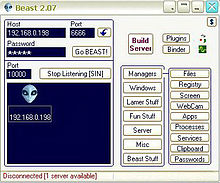- Trojan horse (computing)
-
A Trojan horse, or Trojan, is software that appears to perform a desirable function for the user prior to run or install, but (perhaps in addition to the expected function) steals information or harms the system.[1] The term is derived from the Trojan Horse story in Greek mythology.
Contents
Purpose and uses
Adware
A destructive program that masquerades as a benign application. Unlike viruses, Trojan horses do not replicate themselves, but they can be just as destructive. One of the most insidious types of Trojan horse is a program that claims to rid a computer of viruses but instead introduces viruses onto the computer.
The term comes from the Greek story of the Trojan War, in which the Greeks give a giant wooden horse to their foes, the Trojans, ostensibly as a peace offering. But after the Trojans drag the horse inside their city walls, Greek soldiers sneak out of the horse's hollow belly and open the city gates, allowing their compatriots to pour in and capture Troy.
Security
Trojan may allow a hacker remote access to a target computer system. Once a Trojan has been installed on a target computer system, a hacker may have access to the computer remotely and perform various operations, limited by user privileges on the target computer system and the design of the Trojan.
Operations that could be performed by a hacker on a target computer system include:
- Use of the machine as part of a botnet (e.g. to perform automated spamming or to distribute Denial-of-service attacks)
- Data theft (e.g. retrieving passwords or credit card information)
- Installation of software, including third-party malware
- Downloading or uploading of files on the user's computer
- Modification or deletion of files
- Keystroke logging
- Watching the user's screen
- Crashing the computer
- Anonymizing internet viewing
Trojan horses in this way require interaction with a hacker to fulfill their purpose, though the hacker need not be the individual responsible for distributing the Trojan horse. It is possible for individual hackers to scan computers on a network using a port scanner in the hope of finding one with a malicious Trojan horse installed, which the hacker can then use to control the target computer.[2]
A recent innovation in Trojan horse code takes advantage of a security flaw in older versions of IE explorer and Google Chrome to use the host computer as an anonymizer proxy to effectively hide internet usage. The hacker is able to view internet sites while the tracking cookies, internet history, and any IP logging are maintained on the host computer. The host computer may or may not show the internet history of the sites viewed using the computer as a proxy. The first generation of anonymizer Trojan horses tended to leave their tracks in the page view histories of the host computer. Newer generations of the Trojan horse tend to "cover" their tracks more efficiently. Several versions of Slavebot have been widely circulated in the US and Europe and are the most widely distributed examples of this type of Trojan horse.[2]
Current use
Due to the popularity of botnets among hackers and the availability of advertising services that permit authors to violate their users' privacy, Trojan horses are becoming more common. According to a survey conducted by BitDefender from January to June 2009, "Trojan-type malware is on the rise, accounting for 83-percent of the global malware detected in the world". This virus has a relationship with worms as it spreads with the help given by worms and travel across the internet with them. [3]
See also
- Cyber spying
- Dancing pigs
- Exploit (computer security)
- Industrial espionage
- Malware
- Principle of least privilege
- Privacy-invasive software
- Reverse connection
- Rogue security software
- Secure computing
- Social engineering (security)
- Spam
- Spyware
- Timeline of computer viruses and worms
- Bundestrojaner
References
- ^ What Is the Difference: Viruses, Worms, Trojans, and Bots? - Cisco Systems
- ^ a b Jamie Crapanzano (2003): "Deconstructing SubSeven, the Trojan Horse of Choice", SANS Institute, Retrieved on 2009-06-11
- ^ BitDefender.com Malware and Spam Survey
- Carnegie Mellon University (1999): "CERT Advisory CA-1999-02 Trojan Horses", Retrieved on 2009-06-10.
External links
Malware Infectious malware Concealment Malware for profit Privacy-invasive software · Adware · Spyware · Botnet · Keystroke logging · Web threats · Fraudulent dialer · Malbot · Scareware · Rogue security software · RansomwareBy operating system Protection Countermeasures Categories:- Trojan horses
- Social engineering (computer security)
- Spyware
- Web security exploits
Wikimedia Foundation. 2010.

